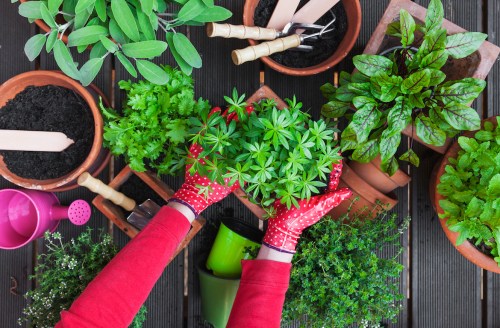5 of the Best Herbs for Indigestion to Grow at Home
Peppermint, thyme, fennel, chamomile, and catnip are five of the best herbs for indigestion. Here's why and how to grow them yourself.

Whether it’s a celebratory meal or stress-induced, it can be easy to eat too much, or eat foods that can be harder for your body to digest, even if they’re comforting to consume. Our stomachs alert us when they’re being overwhelmed, often in the form of indigestion. One way to help with an upset tummy is with an herbal tea, better known as an herbal infusion or tisane, to aid the digestive tract in doing its job. And many of the best herbs for indigestion are also easy to grow at home with garden kits.
Infusions use parts of a plant, usually flowers and leaves, that are steeped in hot water for a few minutes or longer—in the United States, there is a tendency to classify all these types of drinks as tea, but there’s actually a specific tea plant, called Camellia Sinensis. According to Amber O’Brien, MD, a doctor at Mango Clinic in Miami.“Infusions are the best way to get maximum health benefits from these herbs. The warm fluid is easily digestible, and that has a direct impact on the intestinal walls.”
And herbal infusions are not only for adults to enjoy, ones made from peppermint, chamomile, fennel, and catnip (all common herbs for indigestion) can be safely given to the children, according to Dr. O’Brien.
5 best herbs for indigestion…in no particular order
Chamomile
Chamomilla recutita
“Chamomile is full of anti-inflammatory and antimicrobial properties that make it a useful digestive aid,” says Dr. O’Brien. She explains that it contains bisabolol, which can help relax the lining of the muscles. “Chamomile helps with treating diarrhea, nausea, gas, and stomach ulcers,” she adds. It has a mild taste, and is ideal for both adults and children.
How to grow: An annual chamomile can be easily grown from seed or transplants. Plant in rich, well-drained soil and place in an area with ample sun. Although chamomile likes warm climates, too much direct sunlight or heat can make the plant bolt, also known as going to seed.
Catnip
Nepeta cataria
This herb with white or purple tubular flowers that bloom in the summer and occasionally throughout the fall, may be a favorite among feline friends, but don’t let it fool you: Catnip is also tasty to drink. “Since catnip belongs to the mint family, it has anti-microbial and anti-inflammatory properties that deal with an upset stomach,” says Dr. O’Brien. “It’s been used to treat diarrhea, stomach cramps and gas.” With a citrus minty flavor, you may be surprised at how delicious Catnip is and may want this as your new go-to tisane instead of classic peppermint.
How to grow: Once it gets established, Catnip is a hardy, low-maintenance herb that will thrive as long as it’s grown in fertile, well-draining soil and watered sufficiently—but never too much so that the soil is soggy. Grow from seeds with different varieties of catnip or get a jump on the process by buying a starter plant from a nursery. Catnip loves the sun, but it will also do well in partial shade. Just like mint, it can invade other plants or areas of the garden so be sure to plant in a pot or contain it so that it doesn’t take over.
Fennel
Foeniculumvulgare
Fennel is used a vegetable, herb, and as a spice. The bulb, which grows underground, is often used in culinary dishes, such as roasting, grilling, or shaving raw into a salad, whereas the leaves, known as fronds, are typically sprinkled in salads or soups to add a savory, yet milder, anise (aka licorice) flavor. Meanwhile, fennel seeds are used as a spice, as well as to make a tisane to soothe an upset stomach or simply aid digestion. “They have antibacterial, anti-fungal, and anti-inflammatory properties that make these seeds super-effective for indigestion,” says Dr. O’Brien. “Despite their tiny size, fennel seeds contain a significant amount of fiber that contributes to easy digestion and relieving constipation.”
How to grow: Fennel does well when grown from seed, ideally after the last frost date in your region, or start seeds indoors as long as they get plenty of sunlight. If growing outdoors, you can choose to plant them directly into the ground, a raised garden bed, or in pots. (And it’s likely that the following year you may have a few new fennel plants from prior year seeds.) Thriving in full sun, they do best with well-drained, acidic soil with regular waterings, but not saturated. Fennel will go to seed soon after the plant produces flowers, usually in mid-summer or early fall. Saving seeds is simple—shake plants over a blanket, tarp, or sheet to collect seeds easily, and then let them dry before storing them.
Peppermint
Mentha piperita
A mainstay ingredient in many cocktails, lemonade, and in some culinary dishes, peppermint can also aid in soothing the digestive tract. “The effective compounds found in peppermint activate the anti-pain channel in the colon,” says. Dr. O’Brien. “It also calms the muscles of an upset stomach and addresses bloating and indigestion.” With so many varieties of mint, you may wonder if there are any differences between them. “Generally, all types of mint are considered good for stomach disorders; however, peppermint and spearmint are widely used due to their effectiveness,” explains Dr. O’Brien. That said, anyone suffering from GERD or heartburn are best off avoiding peppermint she says.
How to grow: Peppermint is a really easy herb to grow, and you can sow seeds or buy starter plants. Whether you plant directly into the soil or in a container, it’s important to know once this plant gets comfortable, it doesn’t require too much care. But it will spread and can take over other areas of the garden if it’s not contained, so either plant yours in a pot or far from other herbs or plants. Mint loves the sun, but can handle some shade, and will do well in a variety of climates.
Thyme
Thymus vulgaris
A culinary herb that can spruce up many dishes, thyme is known for having an array of properties that are beneficial for the body. It can aid digestion because of its antibacterial and antiviral properties, O’Brien explains. “Thyme contains certain chemicals and antimicrobial properties that reduce germs in food, which then improves gut microbes and overall digestive health,” she says. “It also gives a boost to the protective gastric mucus layers in the stomach, which protects its lining from acid and its effects.”
How to grow: Thyme can be started with seeds or if you prefer, buy seedlings. Ensure your thyme plant gets at least six hours of sunlight per day. Best part? Thyme is a perennial herb, so there is no need to sow seeds every year, because it will continue to return, plus it thrives in most climates. It also makes for the perfect DIY beverage packed with tons of thyme tea benefits.
Oh hi! You look like someone who loves free workouts, discounts for cult-fave wellness brands, and exclusive Well+Good content. Sign up for Well+, our online community of wellness insiders, and unlock your rewards instantly.









